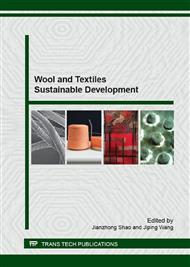p.338
p.347
p.356
p.363
p.369
p.378
p.385
p.391
p.397
Study on Woven Fabric Texture Based on Fourier Transform and Gabor Transform
Abstract:
Woven fabric texture was periodic and complex, the woven fabric texture analysis method was based on Fourier transform and Gabor transform. Firstly the frequency range of woven fabric texture was obtained by using the Fourier Transform method, and the influence on fabric frequency of image resolution and fabric density was analyzed. Then the main parameters of Gabor filter was confirmed by the woven fabric texture frequency, and the sub-images which contain different texture information were obtained after the woven fabric images were decomposed and fused in different scales and directions using the Gabor filters. Finally the main texture enhancement method, the main texture elimination method, the direntional texture analysis method and extraessential texture enhancement method were discussed. The experiment proved that this method would be a powerful tool in the application of texture analysis.
Info:
Periodical:
Pages:
369-377
Citation:
Online since:
November 2015
Authors:
Price:
Сopyright:
© 2016 Trans Tech Publications Ltd. All Rights Reserved
Share:
Citation:


